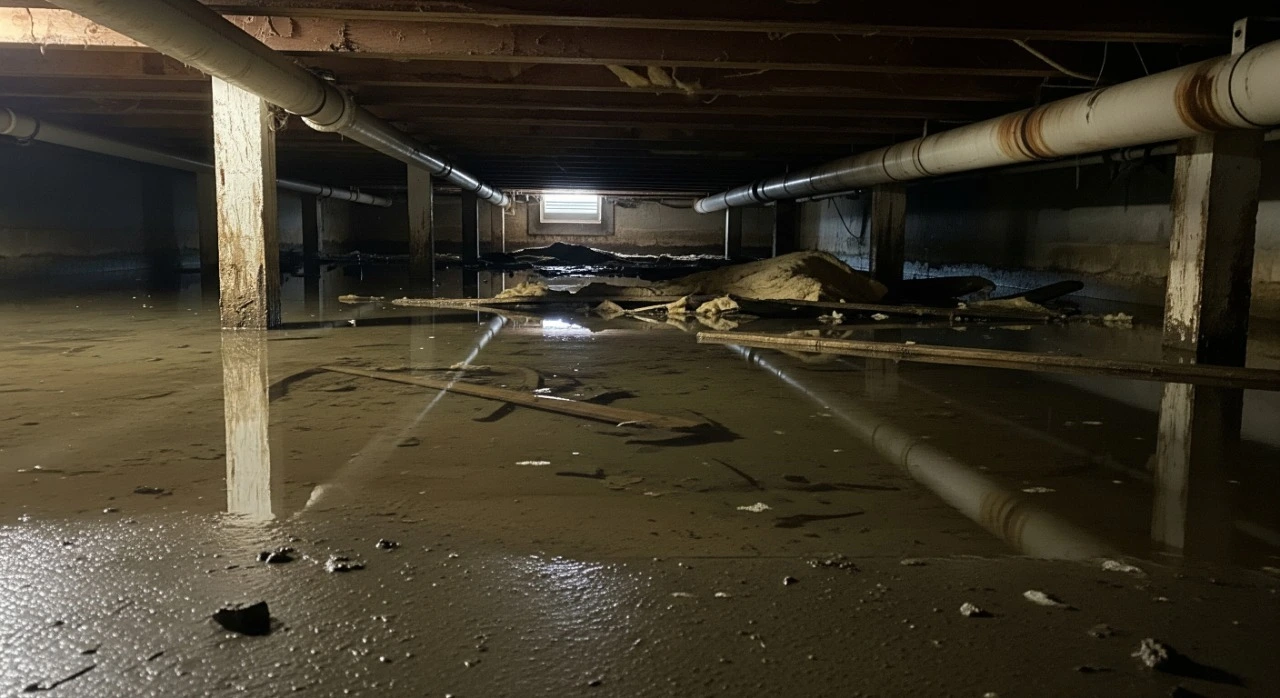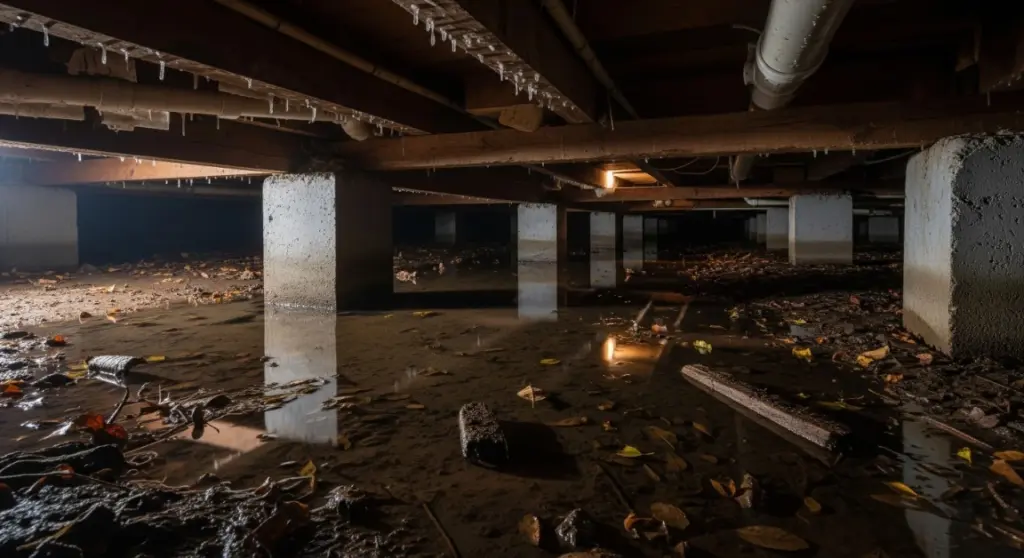
Introduction: The Storm Winds Down, But the Water Remains
The drumming beat of drenching rains against your roof is relaxing, but the quiet after the storm is typically apprehensive to most homeowners. A venture into your crawl space or basement reveals the worst: puddles of water in your floorspace, wet walls, or the incessant drip beneath your house after a thunderstorm. It is a frightening surprise that readily elicits questions: Where is it? How severe is this? And how can I avoid it?
You are not alone experiencing this problem. This is one of the most common issues that homeowners face, and it is a strong indication that the water management system in your home is clogged. If left untreated, this causes catastrophic results from damaging your foundation to serious health problems.
This guidebook will walk you through the most frequent causes your house is susceptible to flooding on a rainy day, the risk of not acting, and an easy step-by-step solution so water stays outside where it should when it rains again next time.
Finding the Causes of Rain Flooding
When that hurricane blows through your crawl space or basement, it’s not bad luck. It’s water and physics following the path of least resistance. Perpetrators always point the finger at one of the following:
- Clogged Gutters and Downspouts Envision your gutters as your front line. When filled up with leaves, sticks, and other debris, rainwater can’t flow freely. Rather, it sheets off to the side and pounds gallons of water down onto your foundation. Short downspouts or non-extended downspouts spout a concentrated flash of water right where you don’t need it, wetting the soil alongside your foundation.
- Negligent Grading and Landscaping Your ground should be a barrier, not an absorbent sponge. Proper “grading” occurs when the ground slopes away from your foundation in all directions. When it is level or worse, slops towards your home (negative grading), it effectively creates a moat. Rainwater pools against your foundation walls, waiting with bated breath for an opening.
- Hydrostatic Pressure: The Hidden Force This is the most powerful force at work. When there has been a rain flood, the soil over and around your footing is saturated with water. Groundwater exerts a tremendous pressure on your foundation floor and walls in the way of hydrostatic pressure. If there is any vulnerability—the slightest crack, a compromised area in the concrete, or an unfastened joint—it will force water into it with unimaginable pressure.
- Cracks in Your Foundation Hydrostatic pressure needs an opening. Sinks over time and even small cracks can form on the wall or floor of the foundation. Though they may be small, these cracks are superhighways for pressured water. What is a dry crack the remainder of the year is an active leak during rain.
The Risks: Why You Can’t Ignore Water Under Your House
A sip of water is not disaster, but its long-term consequence is horrific. Denial that there is an issue is fooling around with your health and the worth of your house.
- Foundation Damage: Ongoing water pressure can destabilize soil under your foundation, causing settling, shifting, and ginormous structural cracks. The water itself will rot concrete and rust and expand rebar, compromising the strength of your home’s overall frame.
- Mold, Mildew, and Stale Smells: Mold and mildew grow as early as 24-48 hours in an environment with high humidity. Mold and mildew release spores into the air, and they migrate from your basement or crawl space into your living areas (the “stack effect”). These provoke allergy, asthma, and other respiratory ailments.
- Pest Infestations: Dark, wet areas are a pest heaven on earth. Cockroaches, termites, mice, and insects love the dampness, adding yet another list of problems to your home.

Your Action Plan for a Dry Home
You might try taking matters into your own hands to fix rain-induced flooding. The solution is a mix of simple maintenance and, if required, professional assistance.
Step 1: Immediate DIY Checks and Fixes
Before hiring a pro, use these inexpensive but highly effective things first:
Clean Gutters: Take out all the leaves and trash on a consistent schedule so water can flow freely off to the downspouts.
Extend Downspouts: Make your downspouts spit water at least 5-10 feet away from your foundation. Less expensive extenders are available at any hardware store.
Check Your Grading: Take a tour of your house. Where. you have sloping areas toward your walls, fill them up with compacted soil to provide you with a positive slope away from your walls.
Step 2: Professional Waterproofing Solutions
When simple fix-ups aren’t holding up, you must hire a professional waterproofer. They offer permanent fixes to take care of extensive water intrusion:
Interior Drainage System (French Drain): It is highly efficient and commonly used. A trench is excavated along the inner edge of the crawl space or basement floor, and a perforated pipe is installed inside it. The system prevents water from where it enters and sends it to a sump pump.
Sump Pump Installation: The sump pump is the basis of your drainage system. It is placed in a basin and sends water that pools automatically away from your house and out of your house, keeping space dry no matter how much rain falls.
Foundation Crack Repair: Experts are able to seal persistent leaks permanently by filling cracks with expanding high-strength epoxy or polyurethane foam to create a firm, watertight seal.
Conclusion: Don’t Wait for the Next Storm
Water in your house following a nasty storm is a straight-out warning that your residence is at risk. Granted, the current reason may be the storm, but the real reason is to be found with your home’s foundation and water run-off. By taking action on it in advance—with the minimum maintenance as a beginning and having a professional suggest a long-term fix—you are able to fix the issue for the lifespan of your home. Save your investment and your family’s well-being by taking a cracked foundation seriously.
Frequently Asked Questions (FAQ)
Q: Is it common to be a bit wet on the wall after rain?
A: No, any water that penetrates your foundation is indicative of something being wrong. A spot of damp is secondary to a puddle, but it represents hydrostatic pressure forcing water through your walls, and it will probably get worse with time or stronger storms.
Q: I simply paint my basement walls with waterproof paint, don’t I?
A: Waterproof paints are a Band-Aid at best. They might give you a surface coating but won’t do anything to correct the hydrostatic pressure on the outside. The pressure will be still transmitted by the water against your foundation and can end up bubbling and delaminating the paint, the underlying structural issues still not resolved.
Q: How much does professional waterproofing cost?
A: Anything from a lot based on the square footage of your house, the severity of the issue, and how much work must be done. A crack injection will be a few hundred dollars, but interior drainage and sump pump installation might be a few thousand dollars. The best value is to have an inspection and bid performed by a professional waterproofing company.


